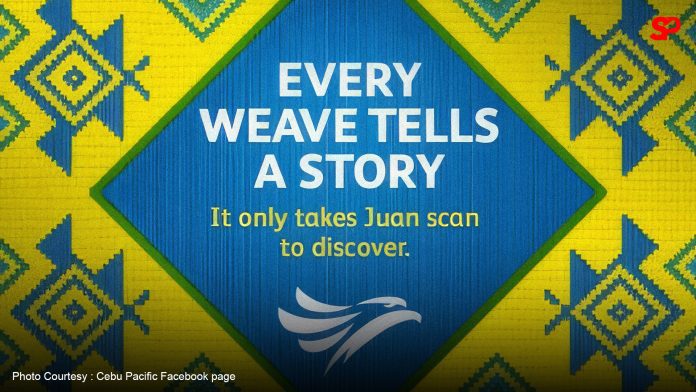MANILA – Low-cost airline Cebu Pacific (CEB) is showcasing Philippine textiles and traditional weaves through QR flight codes placed on major thoroughfares and airports across the country and in select magazines.
The QR flight codes showcase five weaving styles — the intricate and nature-inspired markings of Ilocos Norte’s Binakol, the elegantly-colored stripes of Occidental Mindoro’s Ramit, the bright hues and iconic plaid design of Iloilo’s Hablon, the bold and colorful checkered patterns of Antique’s Patadyong, and the striking geometric patterns and vivid colors of Zamboanga’s Yakan.
CEB said it has partnered with the Department of Science and Technology–Philippine Textile Research Institute (DOST-PTRI) for this new domestic campaign.
“Cebu Pacific takes pride in honoring the rich tapestry of our nation’s cultural heritage. Using our business as a platform for inclusive and sustainable growth, we celebrate the artistry of our local weaving communities, ensuring their timeless traditions are preserved and their stories are appreciated by every Filipino,” CEB chief marketing and customer experience officer Candice Iyog said in a statement.
PTRI Director Julius Leaño said the agency is pleased to partner with CEB as it aligns with their goal to reach a wider audience.
“The convergence of our weavers with yet another window for a wider market brings with it the narrative of their communities and their collective dreams and aspirations as people. Tourism may be enriched further by highlighting not just beautiful sceneries but by our weavers’ arts, creativity and ingenuity,” Leaño told the Philippine News Agency.
“This collaboration celebrates our culture and creative industries as another booster to domestic tourism.”
Leaño said the collaboration’s focus is not just on tradition but on science, technology and innovation.
The campaign, he said, also promotes PTRI’s DigiTELAzation program, which integrates data, information, internet of things, data analytics, robotics, and artificial intelligence to improve the productivity of local handloom weaving and other textile industries.
Meanwhile, CEB said it also collaborated with local weaving communities to ensure that the history and significance of the fabrics are preserved in making the QR flight codes. These partners include the Paoay Weavers of Ilocos Norte supported by Mariano Marcos State University (MMSU); the Hanunuo Mangyan of Occidental Mindoro supported by the Awati Ti Kape Community Development Program; the Baraclayan Weavers Association of Iloilo; the Patnongon Multipurpose Cooperative and Bagtason Loom Weavers Association of Antique; and the Yakan by Oriental Weaves of Zamboanga supported by MMSU.
“Every weave is a community’s cultural fingerprint with a story to tell, just as every destination has a unique offering and experience. We encourage every Juan to scan the QR flight codes to explore more of the Philippines and learn about our rich culture and heritage,” Iyog said. (PNA)

